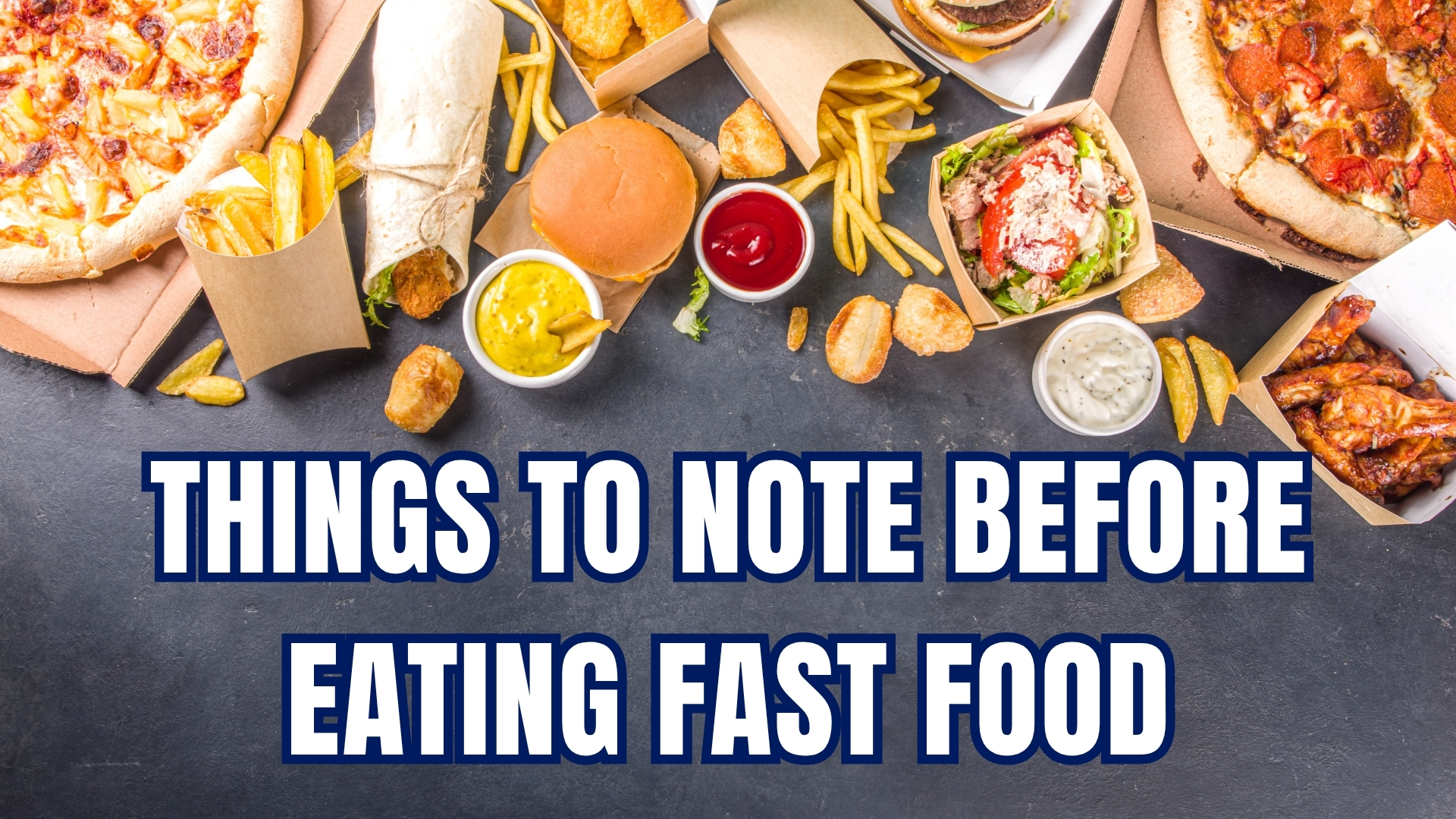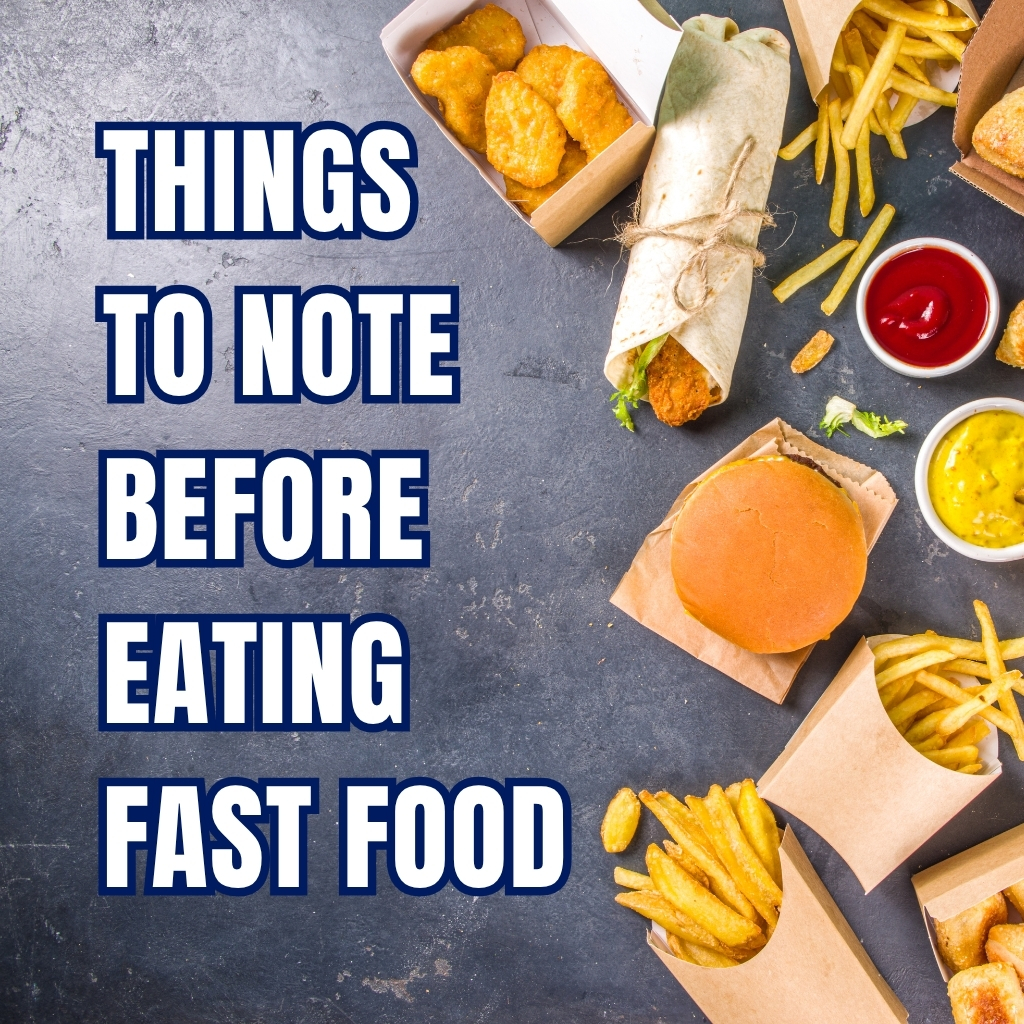Fast food has become an integral part of modern life. With our busy schedules and the convenience that fast food offers, it’s no surprise that millions of people turn to quick-service restaurants every day. Whether it’s a burger on the go, a pizza night with friends, or a quick fried chicken meal, fast food is everywhere. But before you place your next order, it’s crucial to consider the things to note before eating fast food.
Why? Because while fast food is convenient and tasty, it often comes with hidden health risks, nutritional pitfalls, and long-term consequences that many overlook. This article will guide you through everything you need to know before indulging in your next fast food meal. From understanding the nutritional content and potential health risks to making smarter choices and debunking common myths, we’ll help you make informed decisions for a healthier lifestyle.
The Impact of Fast Food: What You Need to Know

Understanding Fast Food
Fast food refers to meals that are prepared and served quickly, typically at restaurants or takeout outlets. These foods are designed for convenience and speed, often at the expense of nutritional value. Common examples include burgers, fries, fried chicken, pizzas, tacos, and sandwiches.
Characteristics of Fast Food:
- High in Calories: Fast food is often calorie-dense, meaning you get a lot of energy in a small portion.
- High in Fats and Sugars: Many fast food items contain large amounts of unhealthy fats and added sugars.
- Low in Nutrients: Essential nutrients like vitamins, minerals, and fiber are often lacking.
- Highly Processed: Ingredients are often processed, preserved, and flavored with additives.
Nutritional Content: What’s Really Inside?
Before eating fast food, it’s important to check the nutritional information. Many fast food chains provide this data on their websites or menus. Here’s what to look out for:
Key Nutritional Factors:
- Calories: Many fast food meals exceed the recommended daily calorie intake in just one sitting.
- Saturated and Trans Fats: These increase cholesterol levels and risk of heart disease.
- Sodium: High sodium can lead to high blood pressure and other health issues.
- Added Sugars: Excessive sugar intake is linked to obesity, diabetes, and dental problems.
- Portion Sizes: Portions are often much larger than what’s considered healthy.
Example: Fast Food Burger Meal
| Item | Calories | Saturated Fat (g) | Sodium (mg) | Sugar (g) |
|---|---|---|---|---|
| Cheeseburger | 300 | 7 | 800 | 7 |
| Medium Fries | 340 | 3.5 | 260 | 0 |
| Soda (16 oz) | 200 | 0 | 20 | 52 |
| Total | 840 | 10.5 | 1080 | 59 |
As shown, a typical meal can easily surpass half of your daily recommended intake for several nutrients.
Health Risks Associated with Fast Food
Short-Term Effects
- Digestive Discomfort: High-fat, greasy foods can cause bloating, indigestion, and heartburn.
- Blood Sugar Spikes: Sugary drinks and refined carbs can lead to rapid increases in blood sugar, followed by crashes.
- Dehydration: Salty foods can make you feel thirsty and dehydrated.
Long-Term Effects
- Obesity: Regular consumption of calorie-dense foods contributes to weight gain.
- Heart Disease: High saturated fat and sodium increase the risk of cardiovascular diseases.
- Type 2 Diabetes: Excessive intake of sugars and refined carbs can lead to insulin resistance.
- High Blood Pressure: Sodium-rich fast foods are a major contributor.
- Nutrient Deficiencies: Relying on fast food can lead to a lack of essential vitamins and minerals.
Special Considerations
- Children and Teenagers: Young people are particularly vulnerable to the negative effects of fast food, as their bodies are still developing.
- Pregnant Women: High sodium and low nutrient content can affect fetal development.
- Individuals with Health Conditions: Those with diabetes, hypertension, or heart disease should be especially cautious.
Making Healthier Choices at Fast Food Restaurants

Tips for Smarter Ordering
- Check the Menu for Healthier Options: Many chains now offer salads, grilled items, and fruit sides.
- Watch Your Portions: Opt for small or regular sizes instead of large or super-sized portions.
- Skip Sugary Drinks: Choose water, unsweetened tea, or diet sodas.
- Customize Your Order: Ask for less cheese, skip the mayo, or request whole-grain buns.
- Add Vegetables: Load up on lettuce, tomatoes, onions, and other veggies.
- Limit Fried Foods: Choose grilled or baked options when possible.
Comparing Fast Food Choices
| Option | Calories | Fat (g) | Sodium (mg) | Fiber (g) |
|---|---|---|---|---|
| Grilled Chicken Salad | 350 | 9 | 780 | 4 |
| Fried Chicken Sandwich | 500 | 22 | 1200 | 2 |
| Veggie Burger | 400 | 12 | 800 | 6 |
| Double Cheeseburger | 600 | 30 | 1300 | 2 |
Choosing grilled or plant-based options can significantly reduce your intake of calories, fat, and sodium.
The Importance of Reading Labels and Ingredients
What to Look For
- Serving Size: Nutritional information is often based on a single serving, but portions may be larger.
- Hidden Ingredients: Watch out for added sugars, artificial flavors, and preservatives.
- Allergens: Fast food often contains common allergens like gluten, dairy, soy, and nuts.
How to Read a Nutrition Label
- Start with Serving Size: All information is based on this amount.
- Check Calories: Consider your daily needs.
- Look at Fats: Limit saturated and trans fats.
- Monitor Sodium and Sugar: Stay within recommended limits.
- Check for Fiber and Protein: Higher amounts are better for satiety and nutrition.
The Role of Moderation
Eating fast food occasionally is unlikely to cause harm if you maintain a balanced diet overall. The key is moderation. Here’s how you can enjoy fast food without compromising your health:
- Limit Frequency: Reserve fast food for special occasions or emergencies.
- Balance Your Diet: Eat plenty of fruits, vegetables, whole grains, and lean proteins at other meals.
- Stay Active: Regular exercise helps offset occasional indulgences.
- Be Mindful: Pay attention to how often and how much you’re eating.
Common Myths About Fast Food
Myth 1: “All Fast Food Is Unhealthy”
While many fast food items are high in calories, fat, and sodium, some chains offer healthier choices like salads, grilled proteins, and fruit sides. It’s about making the right selections.
Myth 2: “Fast Food Is Cheaper Than Home Cooking”
While fast food may seem inexpensive, preparing meals at home is often more cost-effective and healthier in the long run.
Myth 3: “You Can’t Eat Fast Food on a Diet”
With careful choices and portion control, it’s possible to include fast food in a balanced diet.
Social and Environmental Considerations
The Impact on Society
- Obesity Epidemic: The rise of fast food parallels increasing rates of obesity worldwide.
- Food Deserts: In some areas, fast food is more accessible than fresh, healthy foods.
Environmental Concerns
- Packaging Waste: Fast food generates significant amounts of single-use packaging.
- Resource Use: Meat-heavy menus contribute to higher environmental footprints.
FAQ: Things to Note Before Eating Fast Food
What are the healthiest options at fast food restaurants?
Look for grilled items, salads, and sides like fruit or yogurt. Avoid fried foods, creamy sauces, and sugary drinks.
How often is it safe to eat fast food?
Occasional consumption (once a week or less) is generally considered safe for most people, provided the rest of your diet is balanced.
Can fast food fit into a weight loss plan?
Yes, with careful choices and portion control. Opt for lower-calorie items and avoid extras like cheese, bacon, and sauces.
Are there any fast food items suitable for people with allergies?
Many chains provide allergen information. Always check labels and ask staff about preparation methods to avoid cross-contamination.
How can I reduce the negative effects of eating fast food?
Balance your meal with healthier choices, stay hydrated, and maintain an active lifestyle.
Conclusion: Making Informed Choices About Fast Food
Fast food is a convenient part of modern life, but it comes with important considerations. By understanding the things to note before eating fast food—including nutritional content, health risks, and smarter ordering strategies—you can make choices that fit your lifestyle and health goals.
Remember, moderation is key. Enjoy fast food as an occasional treat, not a daily habit. Take advantage of healthier menu options, read nutrition labels, and be mindful of portion sizes. By staying informed and making conscious decisions, you can enjoy the convenience of fast food without compromising your well-being.
